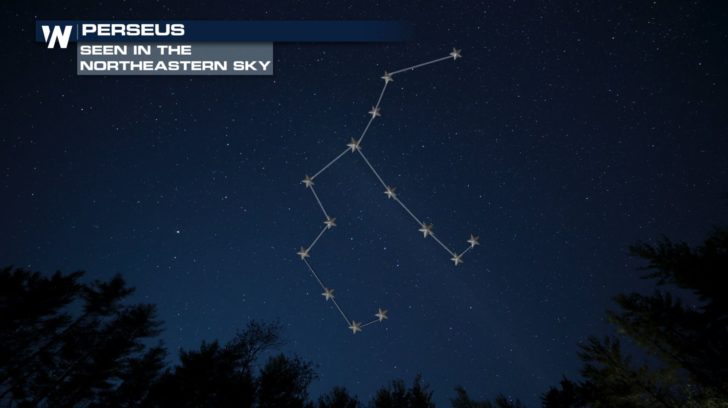Eyes on the Sky: Perseid Meteor Shower
Special Stories
13 Aug 2019 11:28 PM
Get your wishes ready! The peak of the Perseid Meteor Shower has arrived. Skywatchers have been treated to some dazzling displays the past couple of nights. If you still want to see the show, head outside after midnight and get comfortable. It takes your eyes about 30 minutes to totally adjust to the darkness. A nearly-full moon will wash out the fainter Perseids, but don't worry, a few bright fireballs can still be seen.
 The bright Perseids will appear to originate from the the constellation Perseus, it's namesake. Perseus is visible in the northeastern sky. The Perseid Meteor Shower is an annual meteor shower which occurs as Earth passes through debris from the Comet Swift-Tuttle. The shower's peak occurs when Earth passes through the densest, dustiest area. Perseids will still be visible through August 24th.
The bright Perseids will appear to originate from the the constellation Perseus, it's namesake. Perseus is visible in the northeastern sky. The Perseid Meteor Shower is an annual meteor shower which occurs as Earth passes through debris from the Comet Swift-Tuttle. The shower's peak occurs when Earth passes through the densest, dustiest area. Perseids will still be visible through August 24th.
 Any rocky or iron debris flying through space is called a meteoroid. If a meteoroid enter the Earth's atmosphere, it burns up and leaves a streak across the sky, called a meteor. If a piece makes it to the surface without burning up, then it's called a meteorite. Most of the meteors in the Perseid shower are too small for that though. They're about the size of a grain of sand.
Any rocky or iron debris flying through space is called a meteoroid. If a meteoroid enter the Earth's atmosphere, it burns up and leaves a streak across the sky, called a meteor. If a piece makes it to the surface without burning up, then it's called a meteorite. Most of the meteors in the Perseid shower are too small for that though. They're about the size of a grain of sand.
 The Perseids are not the only astronomical show on display tonight. Mars, Saturn, Venus, and Jupiter are also visible early in the morning. Late summer is also a good time to catch a glimpse of the Milky Way.
-Meteorologist Viki Knapp
The Perseids are not the only astronomical show on display tonight. Mars, Saturn, Venus, and Jupiter are also visible early in the morning. Late summer is also a good time to catch a glimpse of the Milky Way.
-Meteorologist Viki Knapp
 The bright Perseids will appear to originate from the the constellation Perseus, it's namesake. Perseus is visible in the northeastern sky. The Perseid Meteor Shower is an annual meteor shower which occurs as Earth passes through debris from the Comet Swift-Tuttle. The shower's peak occurs when Earth passes through the densest, dustiest area. Perseids will still be visible through August 24th.
The bright Perseids will appear to originate from the the constellation Perseus, it's namesake. Perseus is visible in the northeastern sky. The Perseid Meteor Shower is an annual meteor shower which occurs as Earth passes through debris from the Comet Swift-Tuttle. The shower's peak occurs when Earth passes through the densest, dustiest area. Perseids will still be visible through August 24th.
 Any rocky or iron debris flying through space is called a meteoroid. If a meteoroid enter the Earth's atmosphere, it burns up and leaves a streak across the sky, called a meteor. If a piece makes it to the surface without burning up, then it's called a meteorite. Most of the meteors in the Perseid shower are too small for that though. They're about the size of a grain of sand.
Any rocky or iron debris flying through space is called a meteoroid. If a meteoroid enter the Earth's atmosphere, it burns up and leaves a streak across the sky, called a meteor. If a piece makes it to the surface without burning up, then it's called a meteorite. Most of the meteors in the Perseid shower are too small for that though. They're about the size of a grain of sand.
 The Perseids are not the only astronomical show on display tonight. Mars, Saturn, Venus, and Jupiter are also visible early in the morning. Late summer is also a good time to catch a glimpse of the Milky Way.
-Meteorologist Viki Knapp
The Perseids are not the only astronomical show on display tonight. Mars, Saturn, Venus, and Jupiter are also visible early in the morning. Late summer is also a good time to catch a glimpse of the Milky Way.
-Meteorologist Viki Knapp
All Weather News
More